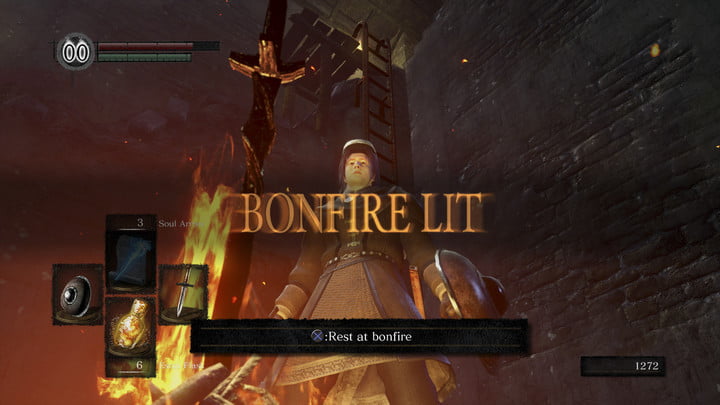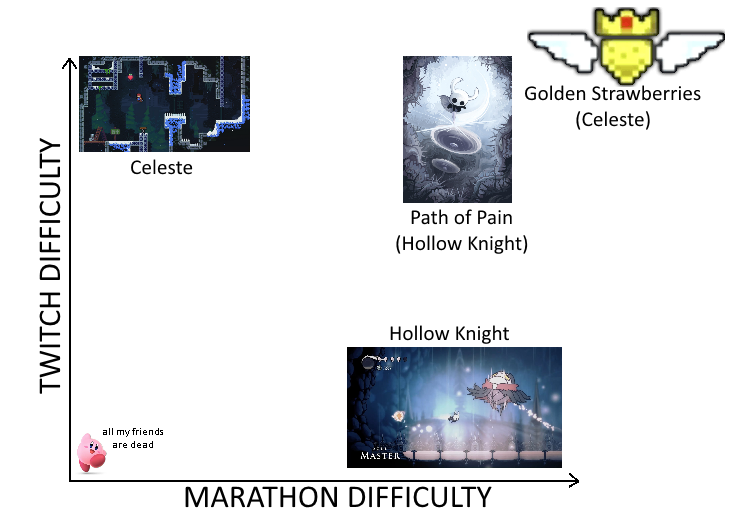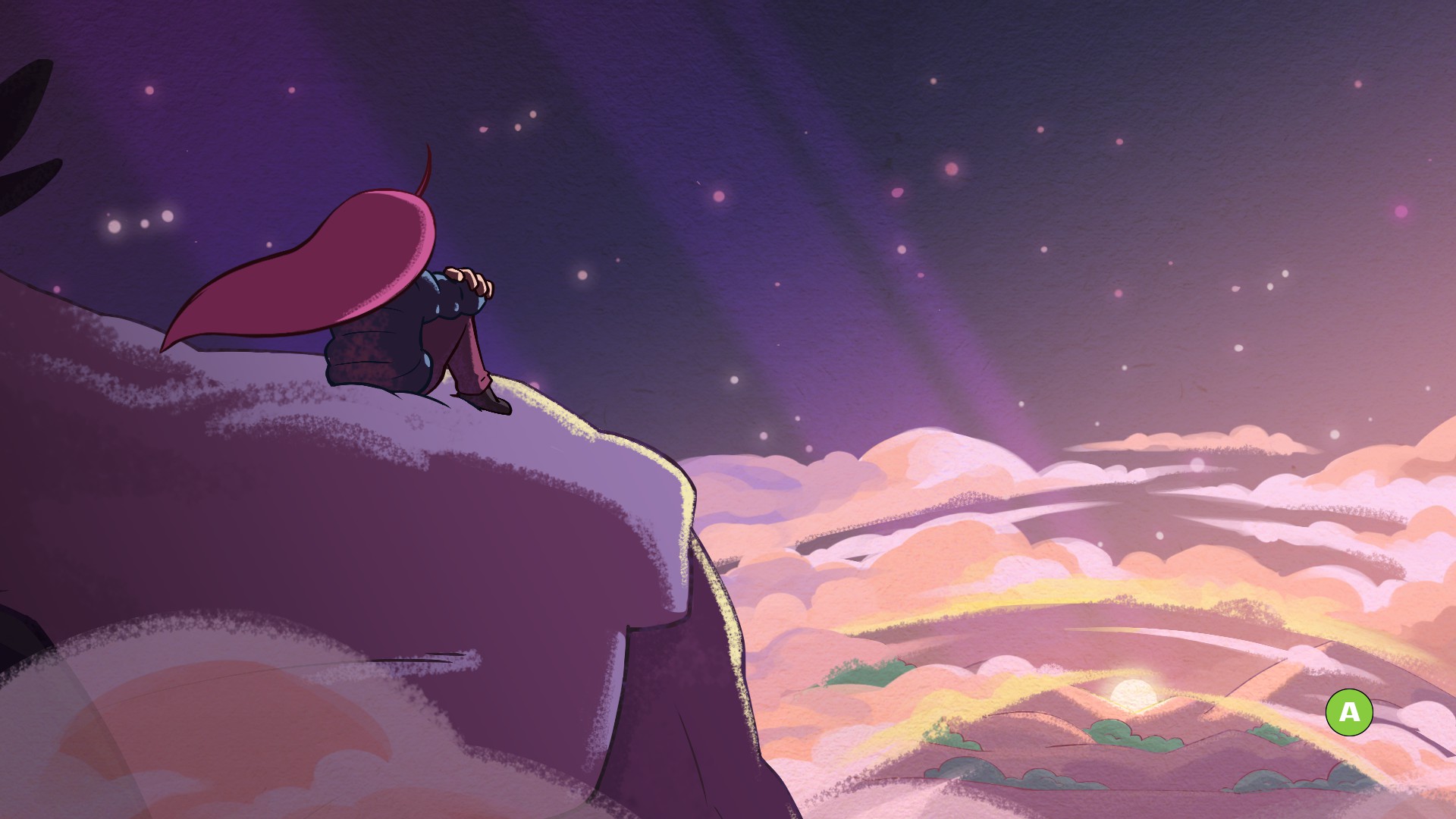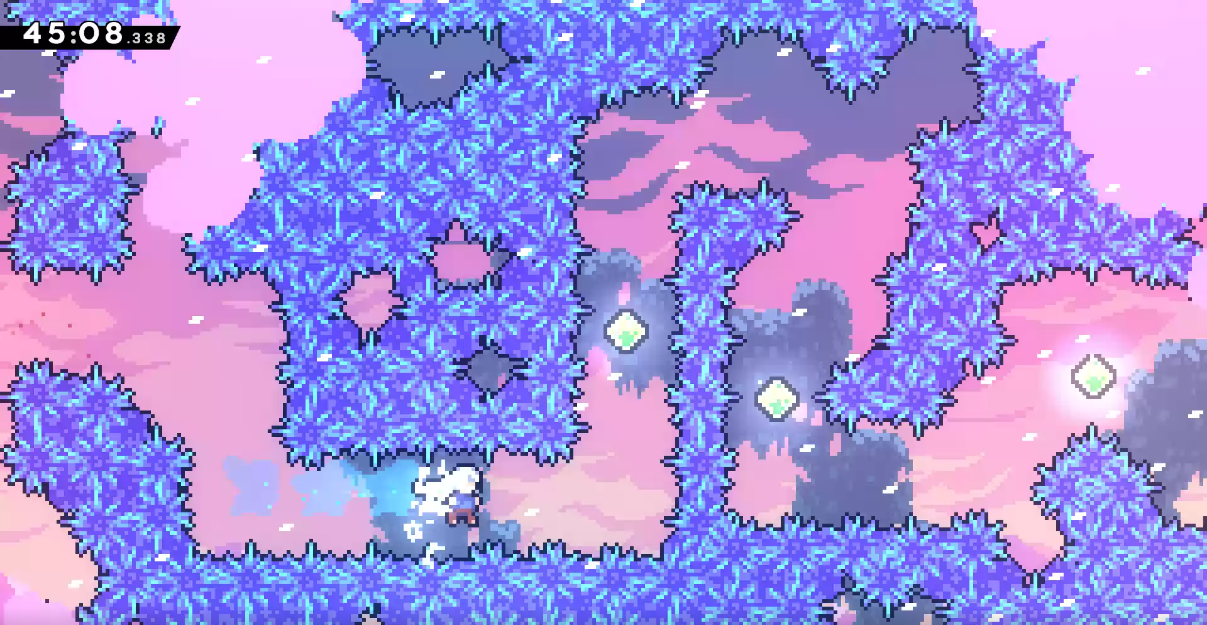Two games I played recently were Celeste and Hollow Knight. Both of these games have the tag "Difficult" on Steam, and having put around 30 hours into each one, I can say that they definitely deserve it. But one thing I noticed is that the two games are difficult in very different ways. Both are 2D platformers with a focus on movement, but Celeste is more about precise control and figuring out the correct path through a short series of obstacles, while Hollow Knight is about long-term survival in high-stakes combat. So what, exactly, are the underlying differences behind these two games' philosophies? Is one of them better? And what lessons can we learn from the way these games do difficulty?
Twitch Difficulty
Here's some gameplay from Celeste:
With some exceptions for advanced speedrunning techniques, the sequences of moves shown here are basically the only way to get through the levels. The challenge is in two parts: analyzing the level to figure out how to move the character through it, then pressing the buttons at the right time to actually execute your solution. If the character falls off the screen or hits spikes, you restart the screen instantly, losing only your progress on that screen. The screens are typically small (especially toward the beginning, they fit entirely on the monitor without scrolling). So dying will only cost you 30 seconds at most, with the exception of the very endgame challenges.
That said, you die a lot. Last time I checked, I had somewhere around 7 thousand deaths; this is about 4 deaths a minute if you average them over my 30 hours of playtime. Celeste is a game about dying over and over again until you finally perfect the moves and clear the screen, and when you do, it feels great.
There are a bunch of other games like this. Super Meat Boy is one that often gets compared to Celeste, as it also has tight controls, small levels, and instant restarts. The arcade-style flash games that were popular when I was in middle school also tended to fall into this category- in The World's Hardest Game I would last seconds before dying, and have to retry the first level dozens of times before I advanced. Playing these games feels frantic and exciting, knowing that you're always just one wrong move away from failure, but it rarely becomes too stressful since the cost of failure is so low.
I call this sort of difficulty "twitch difficulty", because it requires precise, twitchy finger movement and good reaction time.
To adjust the amount of twitch difficulty in a game, the designer has several options. An obvious one is just to make the timing windows tighter or looser. If the player has more time to react and press the appropriate button, the game is easier. Making the timing too strict can feel unfair, though- there's a point where the player will feel like they "totally pressed the button," and that the game is cheating them out of an earned victory. Celeste is notable in that the timing windows are overall pretty generous, so the player can focus more on which buttons to press in which order, and less on millisecond-level thumb precision.
Another way is to adjust the length of segments. As Celeste goes on, the levels gradually become longer, culminating in the sadistically long C-Side levels that take almost four minutes to get through. Four minutes doesn't sound like much, but it's an eternity when you have to play perfectly the entire time. Longer levels provide more opportunities for death as well as increasing the time cost of each death, meaning that a small increase in a level's length can lead to a big increase in the time it takes to complete.
One final way to adjust twitch difficulty is to allow more routes through the level. In Celeste's opening chapters, hazards are relatively infrequent, and the player often has some choice in how exactly to jump and dash to clear each gap. By the end, they are guiding the character through a tiny path in a screen completely filled with spikes. Having more options can let the designer trade precision for planning, and allow the player to direct themself through a level in a more thoughtful way.
Marathon Difficulty
Here's some gameplay from Hollow Knight:
You may notice that the player in the video takes some damage. In fact, they spend most of the fight below half health. They're not playing perfectly, but they're doing a good enough job and managing their health well enough to defeat the boss eventually. This is what I call "marathon difficulty"- you don't have to be perfect, you just have to be good enough for long enough to make it through. It's like running a marathon.
In Hollow Knight, you have health and currency. These are probably the two most important elements of a marathon-hard game- something to keep you from dying instantly, and something to lose when you die. When something finally knocks off your last bit of health in Hollow Knight, you lose all your currency and have to go hunt down your ghost in order to get it back. This process can take a few minutes. Dying is a lot less common, though, since most hits only take off one or two points of health, which can even be regenerated in some circumstances. The overall result is a slower experience, one where the occasional mistake is okay, but consistent poor play will have major consequences.
The Dark Souls series is another example of this type of difficulty. While I haven't played the games, I understand they feature long segments of continual danger from enemies and traps, with both a health bar and currency that you lose when you die (but can be saved at checkpoints). Shovel Knight also works this way- if you die you lose a third of your money and have to replay a bunch of the level, but you can take multiple hits from enemies. I think that pretty much any game with a health bar and currency that you lose when you die is an example of marathon difficulty.
To change a game's level of marathon difficulty, the designer again has several options. They can just adjust the amount of health that the player has, so that the player dies more or less frequently. (Increasing the maximum health over the course of the game and allowing the player to heal themself are both variants of this.) They can change the frequency or damage of enemy attacks and other obstacles, so that the player's health runs out faster. They can alter the consequences for death- maybe the player can retrieve their currency unless they die again before recovering it, or maybe they bank all their currency whenever they reach a new area.

While I haven't formally counted, there seem to be a lot more games that rank highly on marathon difficulty compared to twitch-hard games. I think there are multiple reasons for this- games with health lend themselves more easily to other "deep" systems like upgrades and gear, and they are overall more accessible to gamers with less speedy reflexes. But I don't think that marathon-hard games are automatically "better" than twitch-hard ones.
Combining the Two
Is marathon-hard vs. twitch-hard a useful distinction? I think so.
The games in each category feel very different to play. In marathon-hard games there's often a sort of weightiness, the sense that if I mess up there will be terrible consequences. In twitch-hard games it can feel like running into a brick wall over and over, with no way through but to keep trying dozens more times. When I beat a marathon-hard section I feel relief and safety, knowing that my hard-earned progress is no longer at risk. When I beat a twitch-hard section I feel a rush of power and delight, knowing that I just destroyed that level and I can destroy the next one too. Each type of difficulty has their own applications, techniques, and pitfalls. I haven't seen many other critics differentiate between them, though, aside from a vague "Celeste is a lot like Super Meat Boy" or "Hollow Knight is pretty much just Dark Souls". I think separating these types of difficulty is helpful and lets us look more clearly at why each game works like it does.
But they're not endpoints along the same spectrum. I titled this post "Two Dimensions of Difficulty" because I don't think twitch difficulty and marathon difficulty are mutually exclusive. A game can be twitch-hard without being marathon-hard or vice versa, but it can also be both. In fact, both Celeste and Hollow Knight combine the two in their endgame content.
At the very end of Celeste, special golden strawberries appear at the beginning of each level. If the player collects these, they'll stick around as they progress, until they die, at which point the strawberry disappears. In order to collect one, the player has to beat a whole chapter without dying at all. Chapters can take upwards of fifteen minutes even for a skilled player. Beating them without dying is absurdly difficult. The author of one walkthrough states that "I do not believe that it is statistically possible to get every golden strawberry without using assist mode, or cheating in some way." There's still no health bar, but there is a long-term consequence for death with a big time cost.
Hollow Knight also has a difficult endgame section: the "Path of Pain". While the game's platforming sections are generally pretty lenient, in this area it demands incredible precision and split-second movements. One wrong move, like in Celeste, means failure. However, it keeps the infrequent checkpoints, ability to heal, and high cost of death.
With our two dimensions of difficulty, we can make a graph that looks something like this:

For the sake of discussion, I've oversimplified things a little. Most games, Celeste and Hollow Knight included, consistently have a little of both types of difficulty. In marathon-hard games the player will often find themself in a tight spot where only a clever, precise sequence of moves will save them from disaster. And twitch-hard games inherently have some cost for death, otherwise the player would be effectively invincible. A game completely lacking in one type of difficulty, even if it's possible, probably wouldn't be very good. Balance is necessary to make the game enjoyable.
Keeping Things Fun
Let's assume your goal is to make a fun game. How can you use these two types of difficulty to increase the player's enjoyment of the experience? Games with too little challenge are boring; games that are too hard are frustrating. Now that we know the distinction between twitch difficulty and marathon difficulty, how can we use them both to reach the perfect balance?
Twitch-hard sections are good at making the player feel cool. There is something very satisfying about executing a perfect combo of moves using pure physical skill. But it can be frustrating if the player lacks the required reaction time, and is unable to complete a required section because their fingers can't move fast enough.
Marathon-hard sections are good for a "slow burn" of tension that gradually builds, culminating in a sense of accomplishment once the player survives to reap the rewards. But too much difficulty and these sections can be just as frustrating, forcing the player to replay easy portions over and over just to get another chance at the hard part. There's a fine line between meaningful costs for failure and tedious time-wasting.
Above all, it's important to know which type of difficulty you're aiming for as a designer, and make sure that all your systems are appropriate for it. In Shovel Knight, you have currency, some of which you lose when you die, and a health bar. But the levels are dotted with spikes and pits which instantly kill you regardless of health. I found this experience extremely frustrating and discouraging, as my hard-earned gems were steadily depleted by jumps I just barely missed. This was a twitch-hard mechanic in an otherwise marathon-hard game. In contrast, Hollow Knight's spikes take only one of your health points and respawn you right before the jump you missed. That felt much more fair, and in line with the rest of the game's mechanics.
Finishing Up
I finished Celeste. I did not finish Hollow Knight.
That's sort of vague, so I should clarify. I stopped playing both games when they reached a level of difficulty where I couldn't make any more progress without getting frustrated. Celeste just gave me the end screen before this happened. But Celeste also puts its end screen about a third of the way through the game; I did a few of the extra-hard B-Side levels and didn't even touch the extra-extra-hard C-Sides. In Hollow Knight the end screen is (I think) at the very end of the game; there's not much more after you beat the final boss and win. It's a somewhat arbitrary distinction, and it doesn't technically affect the gameplay very much if content is classified as "post-game" or not. But I feel a lot better about beating Celeste than I do about giving up on Hollow Knight.
So one final suggestion I have for making difficult games fun is: make the game "end" early enough that most players can get to that point, and make the really tough stuff "bonus content" offered as an extra challenge. That way you can accommodate players of many skill levels, and everyone can feel like a winner.

Appendix: More Dimensions of Difficulty
Although twitch-difficulty and marathon-difficulty are the most obvious types in Celeste and Hollow Knight, there are certainly more ways for games to be hard. Another big one is puzzle difficulty- your fingers will have no trouble executing the right moves once you figure them out, but you just don't know what to do! (This is most prominent in games like The Witness.) There's also strategic difficulty, which is similar to puzzle difficulty but is more about adapting to an evolving opponent (as featured in Supreme Commander 2 and Into the Breach). Maybe there's even "narrative difficulty", where you know what to do and how to do it, but for story reasons you don't want to (I haven't played the Telltale games much, but from what I understand they excel at this). Discussing these is out of scope for this blog post, but they can all be mixed together to create interesting multidimensional challenges.


